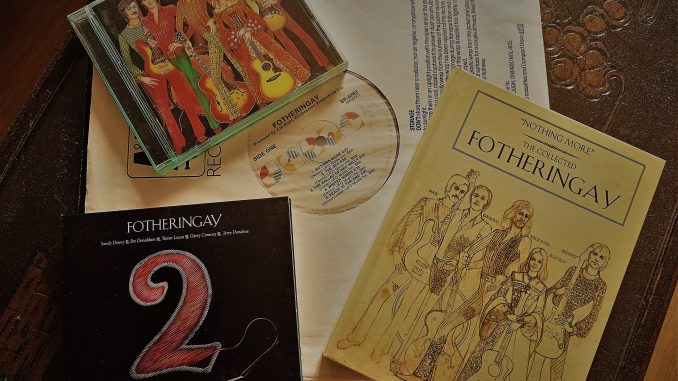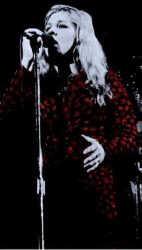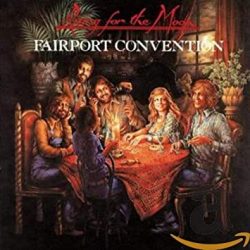
Welcome to a new series of features in which some of our writers will try to justify an Americana tag on a band and/or album that wouldn’t, usually, be associated with this genre.
This series has grown out of a discussion that started on our writers’ forum, where we were talking about bands that had helped to lead us towards Americana but that probably wouldn’t be considered Americana bands in themselves. What do you, the readers, think? We want your input on whether or not we successfully make our case. Can we convince you that the bands we write about could/should be re-evaluated as an Americana band?

Sandy Denny – Fairport Convention (1974).jpg
I’m starting off with what many would consider to be a quintessential Folk-Rock band, Fotheringay. It was formed by Sandy Denny, for many the First Lady of British Folk music so, surely, it must be a Folk-Rock band! Well, I beg to differ. I think there are a number of elements that make Fotheringay a contender for the status of an early Americana band. It should be remembered that one of the main reasons Sandy Denny gave for leaving Fairport Convention was that she didn’t want to concentrate on interpretations of traditional folk songs. She had enjoyed making “Liege & Lief” and had been partly responsible for steering the band towards more traditional music but, with the full-time addition of Dave Swarbrick to the band, she could see that traditional material would become the musical focus for the band, at the expense of original compositions. Her own songwriting was taking off in a big way and this is what she wanted to focus on; so in 1969, she left and formed Fotheringay.
Consider the constituent parts of Fotheringay. Trevor Lucas and Gerry Conway came from the band Eclection, who had one hit with the soft rock/pop-folk song “Nevertheless”. In Trevor Lucas’ own words they were “trying to be a cross between Jefferson Airplane and the Mamas & the Papas”. Jerry Donahue and Pat Donaldson came from Poet and the One Man Band which, at one point, had also included future Emmylou Harris sideman Albert Lee. In many ways, it’s Donahue that, for me, tips the band towards Americana. Born in Manhattan and raised in L.A, Donahue started playing guitar as a child and his early influences included Gerry McGee, who played with The Ventures and who Donahue would study with, alongside Chet Atkins and Duane Eddy. Later influences would include Clarence White and Danny Gatton, who would, eventually, dub Donahue the “string-bending king of the planet”! Unlike Richard Thompson, who Denny had worked alongside in Fairport Convention, Donahue was a distinctly American-influenced guitarist and one who favoured that classic country music guitar, the Fender Telecaster (as opposed to Thompson’s early use of the Gibson Les Paul). If you listen to his guitar work on the Fotheringay recordings it’s all about little riffs and licks, much more in keeping with Americana stylings than Anglo-Celtic Folk music.
The next big influence steering the band away from its Folk-Rock leanings is Trevor Lucas. Lucas was a wild, colonial boy, born and raised in the Melbourne area of Australia. He learned guitar at a young age, as a means to combat his dyslexia, and was soon a fixture around the clubs of Melbourne, singing a mix of folk, blues and “bush ballads”, an early form of Australian country music. As the other major songwriter in Fotheringay, his songs offered a harder, rockier edge than those of Sandy Denny. Lucas and Denny were, of course, partners who would soon marry and, in many ways, Fotheringay was as much his band as it was hers.
 Next, we come to the material they recorded. Fotheringay only recorded one, eponymously titled album during their brief time together. In addition to Denny’s strongly folk-based contributions and Denny/Lucas arranged versions of traditional material we have a couple of interesting covers, one of Dylan’s ‘Too Much of Nothing’, Denny and Lucas were both big admirers of Dylan’s songs, and one of Canadian singer-songwriter Gordon Lightfoot’s songs, ‘The Way I Feel’. Couple these with Lucas’ own ‘The Ballad of Ned Kelly’ and you’ve got a distinct tilt towards American flavoured material that, I believe, would only have grown if the band had stayed together. Though we don’t really have a second Fotheringay album from this period, we do have a Fairport Convention album from five years later, “Rising For the Moon”, that features the Fotheringay line-up of Denny, Lucas and Donahue and you can distinctly hear the Americana influence they bring on this album. Trevor Lucas’ ‘Restless’ is really a straightforward country song in the Merle Haggard tradition, yearning for a life on the road in a big country. There are also some of the songs Sandy Denny was writing in this period, songs like ‘What is True?’ and ‘One More Chance’. Now writing almost exclusively on piano, Denny seems to be re-inventing herself as a British equivalent of a “Tapestry” period Carole King. Take away Denny’s distinctly British voice and you strip these songs of any semblance of folk to reveal the searching ballads that they are. It’s also interesting to look at the material this incarnation of the Fairports was playing on the road; Dylan’s ‘Down in the Flood’ and ‘Knockin’ on Heaven’s Door’, Fotheringay’s ‘Ballad of Ned Kelly’, Earl Green’s ‘Six Days on the Road’ a country music truck driving song that was a staple of Gram Parson’s setlist in both the Flying Burrito Brothers and with The Fallen Angels and even a version of Buddy Holly’s ‘That’ll Be the Day‘. Sandy Denny’s folk-rock days were well behind her by this point and the inclusion of Denny, Lucas and Donahue in the Fairport line-up at this time seems to be re-positioning Fairport Convention as a British version of The Band.
Next, we come to the material they recorded. Fotheringay only recorded one, eponymously titled album during their brief time together. In addition to Denny’s strongly folk-based contributions and Denny/Lucas arranged versions of traditional material we have a couple of interesting covers, one of Dylan’s ‘Too Much of Nothing’, Denny and Lucas were both big admirers of Dylan’s songs, and one of Canadian singer-songwriter Gordon Lightfoot’s songs, ‘The Way I Feel’. Couple these with Lucas’ own ‘The Ballad of Ned Kelly’ and you’ve got a distinct tilt towards American flavoured material that, I believe, would only have grown if the band had stayed together. Though we don’t really have a second Fotheringay album from this period, we do have a Fairport Convention album from five years later, “Rising For the Moon”, that features the Fotheringay line-up of Denny, Lucas and Donahue and you can distinctly hear the Americana influence they bring on this album. Trevor Lucas’ ‘Restless’ is really a straightforward country song in the Merle Haggard tradition, yearning for a life on the road in a big country. There are also some of the songs Sandy Denny was writing in this period, songs like ‘What is True?’ and ‘One More Chance’. Now writing almost exclusively on piano, Denny seems to be re-inventing herself as a British equivalent of a “Tapestry” period Carole King. Take away Denny’s distinctly British voice and you strip these songs of any semblance of folk to reveal the searching ballads that they are. It’s also interesting to look at the material this incarnation of the Fairports was playing on the road; Dylan’s ‘Down in the Flood’ and ‘Knockin’ on Heaven’s Door’, Fotheringay’s ‘Ballad of Ned Kelly’, Earl Green’s ‘Six Days on the Road’ a country music truck driving song that was a staple of Gram Parson’s setlist in both the Flying Burrito Brothers and with The Fallen Angels and even a version of Buddy Holly’s ‘That’ll Be the Day‘. Sandy Denny’s folk-rock days were well behind her by this point and the inclusion of Denny, Lucas and Donahue in the Fairport line-up at this time seems to be re-positioning Fairport Convention as a British version of The Band.
Finally, I would refer you to “Fotheringay 2”, the album painstakingly assembled by Jerry Donahue and finally released in 2008, nearly 40 years after the demise of the band itself and with both Denny and Lucas long departed from this world. It was pieced together from initial recordings for the second album and demos of songs intended for possible inclusion and is a remarkable piece of forensic recording restoration by Donahue, principally, but with the support of many others, including the other remaining members of the band. This sees the inclusion of another country rocker from Trevor Lucas, ‘Knights of the Road’ alongside a re-recording of ‘Restless’, the obligatory Dylan cover, this time ‘I Don’t Believe You’ and Sandy’s version of the country classic ‘Silver Threads and Golden Needles’. Yes, there are still nods to traditional British folk music, but would many of them have made the cut if the band had been actively looking to progress their sound at the time. “Fotheringay 2” is a great album, but something of an artificial construct in terms of the band’s development.
I believe that Fotheringay is the true reflection of Sandy Denny as a musician. She was always at her best with a band around her, she wanted to develop her music within a band of like-minded people and this group of musicians was the band she chose to work with and develop an identity of their own. She never wanted to work as a solo artist and, in many ways, it was her undoing. Joe Boyd, right about so many things when it came to making music in the late 60s and early 70s, was completely wrong in pushing Denny to be a solo artist. She lacked confidence in the role and struggled to establish an audience for her solo work. This, in turn, sapped her confidence as a performer and she was starting to question her own ability before her untimely death. Hindsight is always 20/20 but I do believe that, if they had been left to follow their intuitions, Denny and Lucas, along with the rest of the band, would have continued to develop and grow a natural sound that would now be recognised as an early form of Americana. That combination of English folk melodies alongside Australian swagger and American country guitar picking could’ve forged the band a unique identity at that time. They had great harmony vocals, always a strong aspect of any Americana band, and a roots musicality that goes way beyond a re-imagining of British folk music. These were all musicians heavily influenced by American music and, above all else, they were fronted by one of the great British voices who was also a songwriter of extraordinary ability but who really needed a musical setting and support that would let her natural abilities grow. Fotheringay should’ve been, could have been, the start of a new British ‘Americana’.
What do you, the reader, think? Have I convinced you of Fotheringay’s Americana credentials? Could they be a contender? Only you can decide.



Great article, I think you nailed it. I just grabbed my two Fotheringay albums and having not listened to them for a couple of years, I’m really delighted how wonderful this music sounds. And yes, it’s completely different from Fairport’s music without Sandy Denny. Her songs for me always owed more to Americana than to british Folk(rock). Your remark, that Joe Boyd put Sandy in the wrong artistic direction is very interesting and totally applicable – I try to imagine what could have become of her had Fotheringay or any other band with a similar musical direction lasted longer. It’s just a dream, you know…
Thanks again for this great reminder of a nearly forgotten band. Greetings from Germany!
Many thanks for your comments and glad you liked the article. Also pleased that it sent you to re-visit Fotheringay’s music. As you say, we can only dream about what might have been.
Eclection. Now you are talking. What a wonderful, wonderful band. It’s such a shame that the band, and in particular Kerrilee(?) Male, did not stick around and entertain us with more delights.